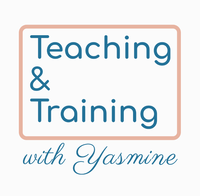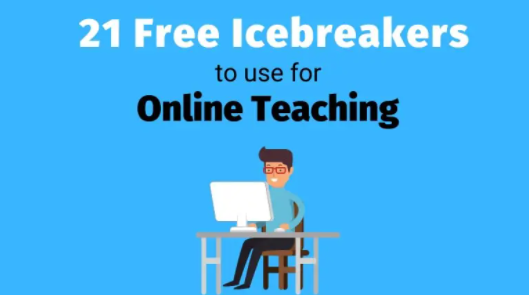- Home
- Teaching Specific
-
Training Specific
- Almost Everything You Need to Know About Being an Effective Trainer
- 9 Essential Skills & Training Tools for Trainers
- Training Needs Analysis
- The 9 Elements that Make Top Employee Training Programs So Successful
- How to Write a Lesson Plan for Corporate Training
- Training Checklists
- Books for Trainers
- Trainer, Facilitator, Presenter: What is the difference?
-
Where the Twain Shall Meet
- Ergonomics
- ESL Volunteer Tutor Guidelines and Expectations
- About Yasmine
- https://americanenglish.state.gov/
Icebreakers, a delicacy
by Edie West
Successful icebreakers are the proverbial frosting on the cake. They enhance the delicate flavor of a training program and help preserve its freshness. Don’t worry if everyone’s taste is different — a well-designed, well-executed icebreaker achieves its purpose anyway. What would a birthday party be without a cake? Just as a German chocolate cake needs a coconut frosting, the success in using icebreakers is in choosing ones with the right ingredients to help set the venue and tone:
Happy baking!
by Edie West
Successful icebreakers are the proverbial frosting on the cake. They enhance the delicate flavor of a training program and help preserve its freshness. Don’t worry if everyone’s taste is different — a well-designed, well-executed icebreaker achieves its purpose anyway. What would a birthday party be without a cake? Just as a German chocolate cake needs a coconut frosting, the success in using icebreakers is in choosing ones with the right ingredients to help set the venue and tone:
- Choose or create an icebreaker that has a real purpose tied to the program outcomes.
- Select icebreaker types that are relevant to participants, the program, and the facilitator.
- Conduct with lighthearted instructions that raise levels of comfort and acceptance.
- Use appropriate humor to enhance the experience.
- Assist participants to draw conclusions that underscore the intent.
Happy baking!
Resources
Here are some more great free resources out there that you can download and start using straight away:
Further Reading about Icebreakers
- Icebreakers & Team Builders PDF by maryville.edu/ this is one of the most comprehensive on the web!
- Ultimate Icebreaker Games PDF – A unique set of ice breakers with great names
- Team Leaders Icebreaker Activities PDF by Seton Hall University an epic list of icebreakers.
- QuizShow Ice breakers PDF – 40 ice breakers from training-games.com
- A Collection of Icebreaker and Connection Activities a book by Julie A. Pack
- 200 Icebreaker Questions PDF by ConversationWorld a simple list with no messing about
- 40 Icebreakers for Small Groups an ebook by Grahame Knox
- High Scool Icebreakers PDF – hmmm the jury is out on this one
- Icebreaker Teambuilding PDF – outlines a great process for setting the scene
- Creative Icebreakers & Introductions – really good for teachers, trainers and facilitators
- Chapter 23 of Training for Dummies - Ten Icebreakers that Work
- 10 Fun Icebreaker activities for students and teachers - For all grades.
Further Reading about Icebreakers
All about Ice Breakers
Have you ever attended a training session when someone droned on for the first 15 minutes about the procedure for completing the sign-in sheet, where the bathrooms are located, how to get to the cafeteria, how to get your parking pass stamped, and on and on? Really got you excited about the training session, I’ll bet!
My hero of icebreakers is Edie West, author, training consultant, and long-time expert on the creation of icebreakers and energizers.
I like to start my sessions with something that surprises or shocks the participants. For example, after being introduced, I have started by walking in with a large shopping bag full of T-shirts and saying, “They say you can’t tell a book by its cover. But I believe you can tell a person by her T-shirt!” I proceed to pull T-shirts out of the bag and read the funny sayings to the group. I hand them a bright sheet of paper (several different colors are used) with the outline of a T-shirt and ask them to use the crayons on the table to draw a picture or write a slogan on the T-shirt that represents their motto or what they stand for.
When participants have all finished designing their T-shirts — and it may take some prodding — I ask them to get up and find all the other participants whose paper is the same color as theirs, to introduce themselves to each other, and to explain their T-shirts (about 5 minutes). I ask them to sit down and have each person introduce themselves and their T-shirts to the rest of the group. At the end I have them all hang their T-shirts on the wall.
You discover in the “Selecting activities” section in this chapter how I use the T-shirt theme throughout the session. But for now, what have I done?
What!?! The content? Yes. I use this icebreaker for the train-the-trainer course that I teach, and after the final introduction, the class begins to process the icebreaker itself. And this is where I slip in a few references about my credibility: “As a trainer for the last 20 years, I. . .” or “As the training director for. . .” or “As I discuss in my last book. . . .”
As I write this I am staring at a quote written by someone who published an article in a training journal: “Icebreakers have nothing to do with course content, but they’re essential if you want people to work together.” Right on the last part, but absolutely wrong on the first part. With a little planning, you should be able to design an icebreaker that introduces the content. See the “Design content-related icebreakers” sidebar for further information.
If a group is composed of people who know each other well, an icebreaker may not be necessary for getting acquainted; there are other opening activities you may need to conduct. The first ten minutes is a very important time for your session. A well-designed opening and icebreaker establish a climate that is conducive to learning.
My hero of icebreakers is Edie West, author, training consultant, and long-time expert on the creation of icebreakers and energizers.
I like to start my sessions with something that surprises or shocks the participants. For example, after being introduced, I have started by walking in with a large shopping bag full of T-shirts and saying, “They say you can’t tell a book by its cover. But I believe you can tell a person by her T-shirt!” I proceed to pull T-shirts out of the bag and read the funny sayings to the group. I hand them a bright sheet of paper (several different colors are used) with the outline of a T-shirt and ask them to use the crayons on the table to draw a picture or write a slogan on the T-shirt that represents their motto or what they stand for.
When participants have all finished designing their T-shirts — and it may take some prodding — I ask them to get up and find all the other participants whose paper is the same color as theirs, to introduce themselves to each other, and to explain their T-shirts (about 5 minutes). I ask them to sit down and have each person introduce themselves and their T-shirts to the rest of the group. At the end I have them all hang their T-shirts on the wall.
You discover in the “Selecting activities” section in this chapter how I use the T-shirt theme throughout the session. But for now, what have I done?
- Grabbed their attention
- Established a participative climate, instant involvement
- Set the pace — fast
- Put people at ease (including the trainer)
- Initiated personal interaction and individual introductions
- Heard everyone’s names
- Had everyone speak once in the large group
- Started to define the group’s personality (trainer observation)
- Started to identify the individual personalities
- Everyone learned something about each other (shortens the path to find other participants with similar interests)
- Established a transition to the content
What!?! The content? Yes. I use this icebreaker for the train-the-trainer course that I teach, and after the final introduction, the class begins to process the icebreaker itself. And this is where I slip in a few references about my credibility: “As a trainer for the last 20 years, I. . .” or “As the training director for. . .” or “As I discuss in my last book. . . .”
As I write this I am staring at a quote written by someone who published an article in a training journal: “Icebreakers have nothing to do with course content, but they’re essential if you want people to work together.” Right on the last part, but absolutely wrong on the first part. With a little planning, you should be able to design an icebreaker that introduces the content. See the “Design content-related icebreakers” sidebar for further information.
If a group is composed of people who know each other well, an icebreaker may not be necessary for getting acquainted; there are other opening activities you may need to conduct. The first ten minutes is a very important time for your session. A well-designed opening and icebreaker establish a climate that is conducive to learning.
Design content-related icebreakers
Icebreakers should have something to do with the content. These four ideas show you just how easy it can be.
Icebreakers should have something to do with the content. These four ideas show you just how easy it can be.
- When participants introduce themselves, ask them to state their names, which department (or company) they are from, and to add one piece of information that relates to the session content. For example, if you’re training problem-solving skills, ask them to identify one example of how they hope to use the skills they are about to learn.
- Ask participants to get into small groups (three to four people) around the table, to introduce themselves to each other, and as a group to decide on the biggest challenge they have that relates to the session content. For example, if you’re teaching listening skills to front desk hotel personnel, you may ask them to decide the biggest challenge they face where listening skills maybe useful.
- In any training session, you can ask participants to identify their expectations for the class.
- You can always bring in a box of “things” (dollar stores are great places to find “things”) and have them select one “thing” and relate it to the content. For example, if you’re training team-building skills, you can provide a box of tools (tape measure, hammer, ice scraper, measuring cup, pancake turner, wire whip, level, scissors, stapler, calculator). Pass the box around and ask each person to select a tool. When participants introduce themselves, they are to complete the statement, “As a team player I am like a ________ because. . . ,” filling in the blank with the tool they selected.
Cite
Biech, Elaine. “Training For Dummies: All About Ice Breakers” Wiley Publishing Inc. 2005. <https://drive.google.com/drive/u/1/folders/1mKfMVolpWBG8AgMiKaVSnBM31DSaekhe> Accessed 07 May 2021.
Biech, Elaine. “Training For Dummies: All About Ice Breakers” Wiley Publishing Inc. 2005. <https://drive.google.com/drive/u/1/folders/1mKfMVolpWBG8AgMiKaVSnBM31DSaekhe> Accessed 07 May 2021.



